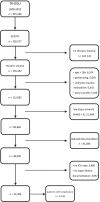Lung failure after polytrauma with concomitant thoracic trauma in the elderly: an analysis from the TraumaRegister DGU®
- PMID: 35197078
- PMCID: PMC8867717
- DOI: 10.1186/s13017-022-00416-0
Lung failure after polytrauma with concomitant thoracic trauma in the elderly: an analysis from the TraumaRegister DGU®
Abstract
Background: In developed countries worldwide, the number of older patients is increasing. Pulmonary complications are common in multiple injured patients with chest injuries. We assessed whether geriatric patients develop lung failure following multiple trauma with concomitant thoracic trauma more often than younger patients.
Methods: A retrospective analysis of severely injured patients with concomitant blunt thoracic trauma registered in the TraumaRegister DGU® (TR-DGU) between 2009 and 2018 was performed. Patients were categorized into four age groups: 55-64 y, 65-74 y, 75-84 y, and ≥ 85 y. Adult patients aged 18-54 years served as a reference group. Lung failure was defined as PaO2/FIO2 ≤ 200 mm Hg, if mechanical ventilation was performed.
Results: A total of 43,289 patients were included, of whom 9238 (21.3%) developed lung failure during their clinical stay. The rate of posttraumatic lung failure was seen to increase with age. While lung failure markedly increased the length of hospital stay, duration of mechanical ventilation, and length of ICU stay independent of the patient's age, differences between younger and older patients with lung failure in regard to these parameters were clinically comparable. In addition, the development of respiratory failure showed a distinct increase in mortality with higher age, from 16.9% (18-54 y) to 67.2% (≥ 85 y).
Conclusion: Development of lung failure in severely injured patients with thoracic trauma markedly increases hospital length of stay, length of ICU stay, and duration of mechanical ventilation in patients, regardless of age. The development of respiratory failure appears to be related to the severity of the chest trauma rather than to increasing patient age. However, the greatest effects of lung failure, particularly in terms of mortality, were observed in the oldest patients.
Keywords: Geriatric patients; Lung failure; Thoracic trauma.
© 2022. The Author(s).
Conflict of interest statement
Prof. Lefering is a member of the Committee on Emergency Medicine, Intensive Care, and Trauma Management (Sektion NIS) of the German Trauma Society (DGU). His institute receives financial support from the AUC - Academy for Trauma Surgery, the operator of the TR-DGU, as part of a cooperation agreement that also includes the statistical support of scientific publications. The other authors declare that there is no conflict of interest.
Figures




References
-
- Federal Statistical Office (Destatis). Older people in Germany and the EU. 2016.
-
- Federal Statistical Office (Destatis). A changing population: assumptions and results of the 14th coordinated population projection. 2019.
Publication types
MeSH terms
LinkOut - more resources
Full Text Sources
Medical

